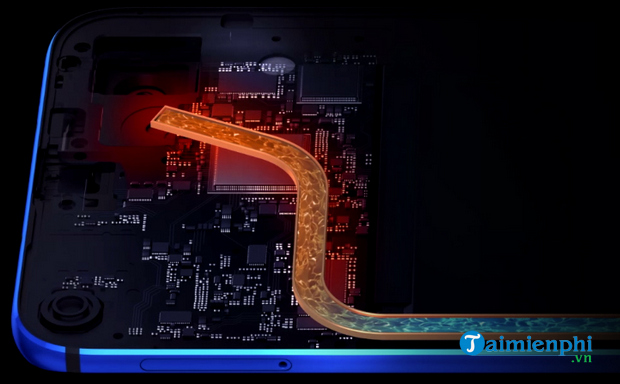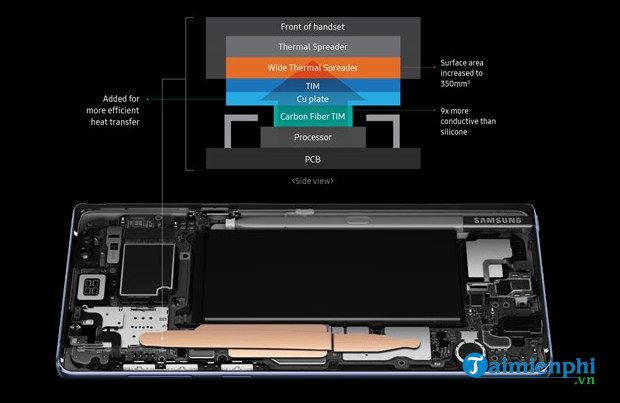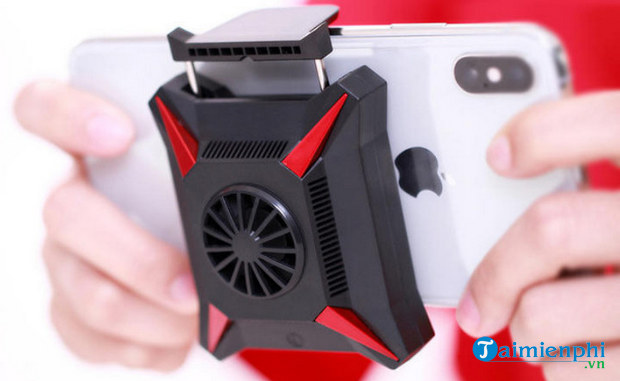What is a heatsink on a phone?
Modern smartphones today are like miniature computers that fit in your pocket . They are extremely powerful with CPUs and GPUs that are more capable than older PCs. When packing all this power into such a small space, keeping hardware cool has become a challenge for device manufacturers.
Learn about heat dissipation on phones
Most phone manufacturers have to think outside the box to find the right solution to keep their phones running well as performance increases. So what is a heatsink on a phone? What outstanding heat dissipation technologies are there?
1. What is a heatsink on a phone?
Phone temperatures increase due to many different reasons, due to both internal and external factors, but the main culprits are still the battery, processor and screen. Each of these components can generate heat; Chemicals inside your phone's battery create electricity, the processor transmits information at high speed (like a computer), and your phone's screen emits light.
The need to use phones is gradually increasing, because phones can now do many tasks that could only be done on computers before, and at the same time, countless games with great graphics for mobile phones have been born . survival ., which requires mobile devices to have more powerful processors. When your phone runs heavy applications, more heat is generated and finding a solution becomes more challenging.
Heat dissipation simply means cooling. Without a heat dissipation system, high temperatures will damage components, reduce phone life, and in the worst case, can cause a fire or explosion. Thermal management products are designed to minimize or cool down the heat generated by frequent operation of electronic devices, to improve their reliability and prevent failures. Cooling on mobile devices comes in two basic forms: passive and active.
2. What is active heat dissipation and passive heat dissipation?
Passive cooling is great, due to the fact that it makes no noise, is usually not likely to fail suddenly, and does not require a power source. Meanwhile, active cooling technologies help reduce temperatures faster and more effectively, but often have disadvantages in size, power requirements, noise and cost, specifically mobile cooling fans. .

The oldest and most widely used passive heat dissipation methods are Heat Sink and Heat Spreader . A basic Heat Sink is simply a heat exchanger that transfers heat from one device, such as a CPU, to another. Heat Sink comes in many different sizes and forms. Typically, Heat Sink uses a heat-conducting metal, such as aluminum or copper, that is physically attached to the heat-generating component. Heat is transferred from the component to the Heat Sink through conduction and then dissipated across the surface of the Heat Sink into the surrounding air through natural convection.
A more sophisticated type of Heat sink is the Heat spreader which works by transferring heat from its source to a secondary heat exchanger with a larger surface area and geometry. Typically, a flat plate formed from a thermally conductive material, such as graphite, is used to capture heat and transfer it to the mobile device's external metal frame and ultimately into the environment. Most smartphones today rely on some form of Heat spreader to dissipate heat.
3. Some common heat dissipation technologies
Phone manufacturers such as Samsung, Sony, Asus or OnePlus have applied liquid cooling and Carbon cooling technology in their products. In addition, users can also purchase external cooling fan accessories to cool the phone (active heat dissipation).
3.1. Liquid cooling
Liquid cooling systems have appeared on Microsoft's Lumia 950XL, Sony's Xperia Z2, and Samsung has applied this technology to the Galaxy S7, using copper heat pipes to disperse heat away from the CPU, especially when chip works harder. There is a little liquid in this tube (not enough to see that the tube is cut). Liquid cooling works by condensation. As the processor heats up, the liquid evaporates, keeping the CPU cool. The vapor then travels to the opposite end of the heat pipe, where it condenses back into a liquid when cooled. This process, combined with carbon fiber TIM (Heat Dissipation Material) is a very effective method of cooling the phone hardware.
3.2. Carbon heatsink

Samsung expanded on the idea of liquid cooling with a Carbon cooling system on the Note 9. With the Note 9, Samsung knew the company needed more cooling power than the S7 (or any phone before it). . Samsung achieved this in two ways: incorporating a wider heatpipe and adding a layer of copper in between the two heatsinks for more heat transfer.
The entire cooling system works on layers. Right above the processor, there is a layer of carbon fiber underneath a thin piece of copper. Above that is another unknown heat transfer material and then copper heat pipes. Right above the heat pipe is a heat dispersion device to keep heat from concentrating in one place.
3.3. External cooling fan

Perhaps you are familiar with laptop cooling fans and it is not strange that phones also have such cooling products. Many people may think that a phone cooling fan is a strange idea, but it is actually useful especially when the phone overheats during gaming. The cooling fan works by connecting to the phone or power source via USB cable. However, you should connect it to a power source instead of plugging it directly into the phone because this will drain the battery quickly.
You should read it
- Top 5 best heat sinks 2019
- Processing effective heat dissipation fan for Laptop V2, there must be a temperature clock with only 60,000 VND
- Green technology
- How to use phones and laptops in hot weather
- Liquid heat sink
- The 1-0-2 radiator combined with air and ice heat makes PC people surprised by creativity
 How to play Grand Theft Auto 5 Online with friends
How to play Grand Theft Auto 5 Online with friends Good tips for using Gmail more effectively on Laptops and PCs
Good tips for using Gmail more effectively on Laptops and PCs How to crop photos on Windows 11/10/7 computers and MacOs
How to crop photos on Windows 11/10/7 computers and MacOs Top 10 best DJ software
Top 10 best DJ software Top running applications, measuring running distance
Top running applications, measuring running distance Top best exercise apps
Top best exercise apps